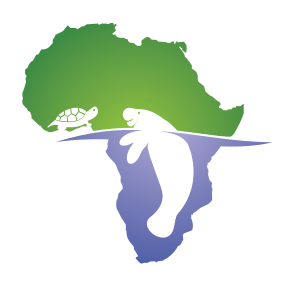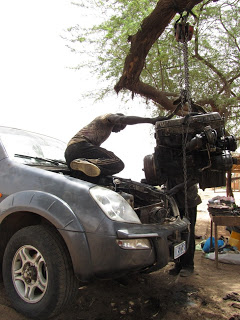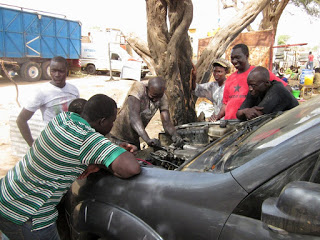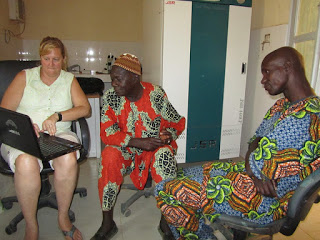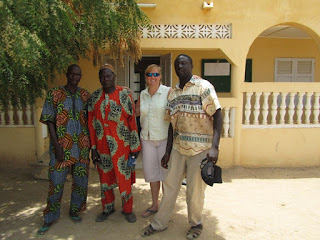On Thursday the new car engine was put into our car. Yes, that’s it hanging from a tree in the photo above! The mechanics spent hours hooking up the various tubes and wires, and I naively thought this meant we were close to being finished with the repairs. Tomas and I discussed where we would drive first- should we continue our original plan to drive down the eastern shore of Lac de Guiers, or head further east to Matam, where I need to collect critical samples? We felt optimistic that we’d be on the road within hours.
The engine installation has been a team effort-Tomas’s mechanic friend Billy (on right in black shirt) came up from Rufisque to oversee the repairs, and our friend Mamadou (in red shirt) came with him since he knows the owner of the car. Both are here to make sure the local mechanics do a good job.
But the mechanics tried the new engine and found that several important components weren’t working. Tomas called the place in Dakar where the engine had been purchased, and they told him they’d be happy to exchange the parts for free… but of course they are 9 hours away in Dakar! In the end we sent the defective parts by car to a friend in Dakar so he could take them to the shop, exchange them and put the new parts back in another car to Richard-Toll. This process has now taken 2 days. The local mechanics basically shrugged because this is the norm here, surely you can’t expect something to work correctly on the first try!
In order to keep from beating my head repeatedly against a wall, I asked Tomas if he could think of anyone else we could talk to about manatees in this area. He made some calls and found out that an older gentleman, Mr. Badji, who had worked here with the Water and Forestry Dept. (the equivalent of US Fish and Wildlife Service in the USA) for 11 years during the 1970’s and 1980’s, happened to be back here now as a consultant for the local pisciculture station (fish farm). Tomas had heard about Mr. Badji previously, because everyone had said he had the best local and historical knowledge of manatees for this area (lower Senegal River and Lac de Guiers). Tomas gave him a call and he was happy to meet with us, so we took a taxi over to the fish farm (which was an impressive place!) and talked with Mr. Badji for several hours.
Suffice it to say Mr. Badji had an incredible wealth of information about manatee projects, unpublished reports, and basic habitat use before and after the construction of the Diama dam in 1984. This is important because the dam greatly altered the Senegal River and Lac de Guiers ecosystems, and changed the behavior of many species of wildlife forever. Water flows that had been highly seasonal are now mechanically controlled, and in many cases this results in a benefit for manatees because there is year round water in Lac de Guiers, and more plants to eat. Mr. Badji had many personal observations of manatees, their former migrations, and known favorite habitat locations. Many of these were new to me, but everything made sense based on the former water flow patterns of the Senegal River.
I showed Mr. Badji (in red) some of my recent genetics and tracking data from the Senegal River. We talked about what I’d like to do in the future, and my hopes for a better understanding of this permanently isolated population. He is a very personable man, but what I liked most about Mr. Badji is that he’s clearly a real field biologist, someone who has spent alot of time in the field and carefully observed the wildlife and patterns of behavior. I hope we’ll be able to meet again in the future, because I think Mr. Badji has much more information to share!
Group photo of Niaga, Mr. Badji, me and Tomas outside the fisheries center.
Our meeting with Mr. Badji was definitely a highlight of our time in Richard-Toll, and has made me even more eager to get back on the road! Fingers crossed it’ll happen soon!

